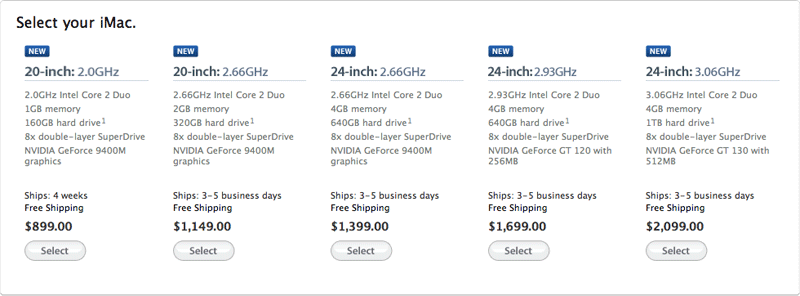Buyers authorized to make purchases for their educational institution can begin pre-ordering the new aluminum systems today for delivery in about a month. Each $899 20-inch iMac includes a 2.0GHz Intel Core 2 Duo, 1GB of memory, 160GB hard drive, 8x double-layer SuperDrive, and a NVIDIA GeForce 9400M graphics subsystem.
The new offering replaces a $899 version of Apple's white 17-inch iMac that the company had held over since 2006 in an effort to allow institutions hit hard by tax revenues declines to continue to factor Macs into their refined budgets.
Interestingly, the move comes less than a month after the Mac maker issued an eNews letter promoting updates to the legacy 17-inch systems, suggesting something in the last three weeks prompted the company to upgrade the specialized $899 offering to the latest aluminum designs, which feature a display with a 3-inch wider viewing area.
The news also means that the white iMac casing, introduced in August of 2004 as the enclosure for the then cutting-edge iMac G5, has now officially been put to rest. All iMacs, both education and consumer, now use the Aluminum design introduced alongside updated iMacs in August of 2007.
Apple's new iMac lineup for educational institutions.
The new $899 iMac is available for order from the Apple Store for Education Institutions but is not available to individual educational buyers or students with access to the Apple Store for Education.
 Sam Oliver
Sam Oliver








 Christine McKee
Christine McKee
 Marko Zivkovic
Marko Zivkovic
 Mike Wuerthele
Mike Wuerthele

 Amber Neely
Amber Neely
 Sponsored Content
Sponsored Content
 Wesley Hilliard
Wesley Hilliard









64 Comments
I thought we had seen the last of 1GB Macs. Oh well. Someday....
I thought we had seen the last of 1GB Macs. Oh well. Someday....
Do school computers really need more than 1GB?
That was what i thought too!
The only Uni in my country that use iMac and not PC are the art related and 1Gb can not be good for 3D modeling!
Do school computers really need more than 1GB?
Browser today like Firefox can eat up 200MB easily, especially when running several Web 2.0 apps or running the useless Flash at the same time.
Great price point, but I always think a 20" monitor is just too big for students. It reminds me of the "Easy" internet cafes you would see in Europe... almost like a factory with the ratio of human space to computer space.